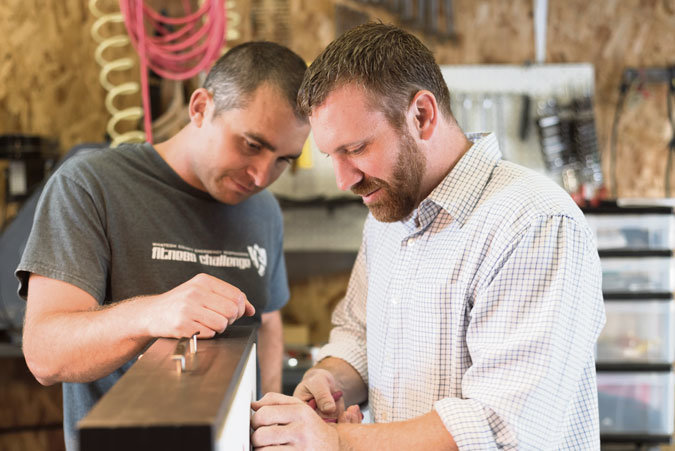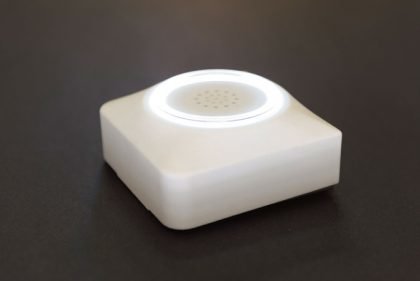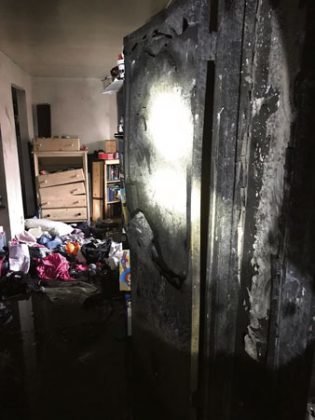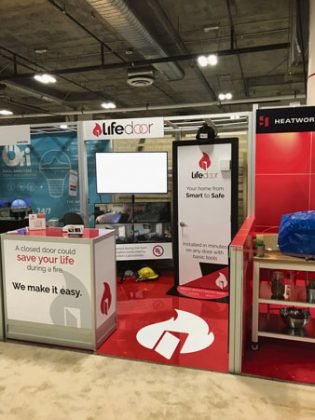 LifeDoor co-founders Joel Sellinger, l., and Ben Docksteader. Photos courtesy of Joel Sellinger
LifeDoor co-founders Joel Sellinger, l., and Ben Docksteader. Photos courtesy of Joel Sellinger
By Stefanie Donahue
Aside from advising people to “stop, drop and roll” should they find themselves on fire, safety professionals across the nation are teaching kids and parents alike to “close the door before you doze.”
The message is supported by studies conducted by the Firefighter Safety Research Institute (FSRI), which found that rooms with an open door average 1,000 degrees Fahrenheit during a house fire, while rooms with a closed door average 100 degrees. FSRI reports that people generally have about three minutes to escape a house fire in comparison to 40 years ago, when people had about 17 minutes. This is due, in part, to a rise in use of synthetic construction materials and furnishings as well as the open layouts of modern homes.
“The stats shocked me,” said career firefighter and Blaine resident Joel Sellinger. In response, Sellinger invented LifeDoor – a product he co-created with engineer and Custer resident Ben Docksteader – and recently unveiled at The International Consumer Electronics Show (CES) in Las Vegas. About the size of a book, LifeDoor mounts to hinges on interior doors and automatically closes doors when a home smoke detector sounds.
 Product prototype.
Product prototype.
Intended for non-commercial buildings, LifeDoor closes a door automatically during fires and also illuminates the room and sounds a secondary alarm. Once closed, the door can easily be reopened. Sellinger said product beta testing will likely begin this year.
“LifeDoor solves a real problem in the world,” said Docksteader in an email. “It’s not merely for novelty or convenience. It can help people and provides unique safety benefits.”
Sellinger first heard the phrase, “Close the door before you doze” at North Whatcom Fire and Rescue, where he was hired as a full-time firefighter in 2012. He regularly joined other district firefighters at the Blaine school district to educate kids about fire safety using classroom materials provided by the Underwriters Laboratories (UL). UL oversees the FSRI and is a leader in fire safety research and education. At the time, “UL wanted ‘close the door’ to be the new ‘stop, drop and roll,” Sellinger said.
Despite his belief in the concept, Sellinger said applying the lessons at home wasn’t easy. His 11-year-old daughter Makayla was uncomfortable shutting her door and so was he. “I never close my door,” he added. “I want to know what’s going on in my home at night.”
In search of a solution, he tried to find a product that would automatically shut a door in the event of a fire but found nothing. In January 2017 he contacted Docksteader, who has worked in manufacturing for 20 years, to help create the product he’d been searching for. It took dozens of designs for the pair to determine a prototype and in March they filed for their first patent.
The move was a big step forward for Sellinger who said he’s seen first-hand how a closed door can make all the difference in a fire.
 A photo from the scene of a January apartment fire in Everett. Just a door separated twin girls from the blaze.
A photo from the scene of a January apartment fire in Everett. Just a door separated twin girls from the blaze.
Currently a firefighter for the city of Everett, he responded to an apartment fire just last month that involved three-year-old twin girls who were home alone and napping in a bedroom. The large blaze engulfed two floors of the building, but luckily for the girls, their bedroom door was closed and they were unharmed – the apartment, on the other hand, was destroyed.
Incidents like this make the pair confident LifeDoor could save lives – and they’re not the only ones.
In January, Sellinger and Docksteader debuted their product at CES. The duo joined 800 other exhibitors in Eureka Park that was set up specifically for startups launching new products or services.
Sellinger said they took home several awards, including “Best of Pre Show” and “Most Important Startup of CES.” The pair also won the CES Techstars Pitch Competition, which landed them in meetings with executives from Target and Amazon – as a result, they’re bringing LifeDoor down to San Francisco this month for temporary display at Target’s ‘Open House’ store, which the international retail chain calls “part retail space, part lab, part meeting venue for the connected home tech community.”
 The LifeDoor display at CES.
The LifeDoor display at CES.
“CES was a great experience because it provided so much validation of the idea and our direction,” Docksteader said. “Of course, any company founder has to thoroughly believe in the core product but having so much positive feedback from a wide swath of people in tech, retail and media was a huge help. We also met a lot of people who are interested in partnering with us in different capacities which is going to help enormously this year. We’re raising some funding, hiring a few more people, doing some beta testing and then going into mass production, so it’s going to be a busy year.”
So far, Docksteader and Sellinger have funded LifeDoor out of pocket, but they’re working on obtaining seed funding now, Sellinger said. They’ve also signed multiple non-disclosure agreements with alarm companies and box stores that are interested in selling their product, he said.
“At a minimum, we’d like people to learn that they should close their door,” Sellinger said. Docksteader added, “I usually tell people, even if they don’t see themselves using LifeDoor, they should at least look at the UL data and info on closeyourdoor.org or search the hashtags #closeyourdoor or #closebeforeyoudoze. The evidence is amazing on the difference it can make in a fire.”
To learn more about LifeDoor, visit lifedoor.io.
Comments
No comments on this item Please log in to comment by clicking here